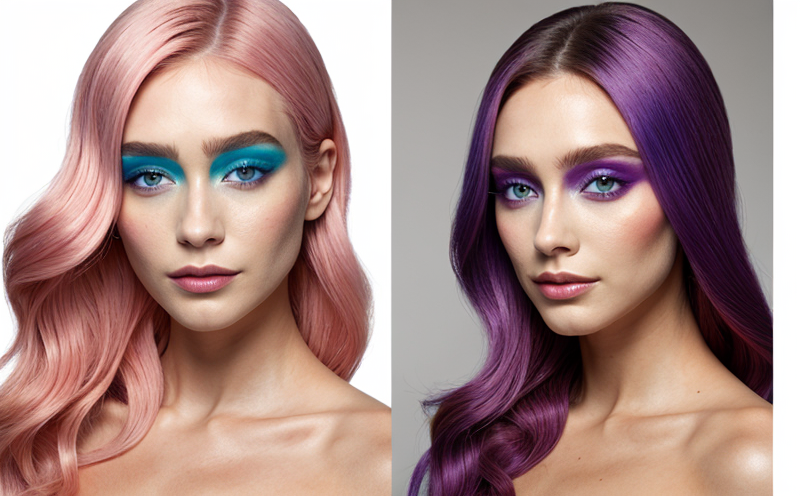Synthetic Dye Safety Testing in Makeup Products
The use of synthetic dyes in cosmetics has been a cornerstone of creating vibrant and appealing makeup products. However, the safety assessment of these dyes is critical to ensure they do not pose any adverse effects on consumers. Synthetic dye safety testing involves a meticulous evaluation process aimed at identifying potential hazards associated with the dyes used in cosmetic formulations.
Synthetic dyes are often derived from petroleum or coal tar sources and can vary widely in their chemical composition, depending on their intended use and color. This variability necessitates comprehensive safety assessments to ensure that they meet regulatory requirements and do not pose risks such as irritation, sensitization, toxicity, or carcinogenicity.
Our synthetic dye safety testing service is designed specifically for cosmetic manufacturers who need to comply with international standards and regulations governing the use of synthetic dyes. This service ensures that your products are safe and meet all necessary requirements before they reach the market.
The testing process typically begins with a detailed review of the product formulation, including an examination of the dye's chemical structure and its concentration in the cosmetic base. This step is crucial as it helps identify potential risks associated with the specific dye used. Following this, various tests are conducted to evaluate different aspects of safety.
These tests may include:
- Acute toxicity testing: To assess any immediate harmful effects on laboratory animals when exposed to high concentrations of the dye.
- Skin irritation and sensitization tests: To determine if the dye causes allergic reactions or skin irritations upon contact with human skin.
- In vitro cytotoxicity studies: Using cell cultures to observe whether the dye can cause cellular damage at various concentrations.
Each test provides valuable insights into the safety profile of the synthetic dye, helping manufacturers make informed decisions about product formulation and labeling. By adhering strictly to international standards such as ISO 10993-1:2018, our service ensures that your products are not only safe but also compliant with global regulations.
Our team of experts works closely with clients throughout the testing process, providing guidance and support every step of the way. From initial consultation to final report delivery, we ensure a smooth and efficient service experience. This level of collaboration ensures that all necessary information is gathered accurately and timely, leading to reliable test results.
| Test Type | Purpose | Methodology |
|---|---|---|
| Acute toxicity testing (LD50) | Determine lethal dose for 50% of test subjects. | Administer dye solution to laboratory animals and observe for signs of toxicity over a defined period. |
| Skin irritation tests | Evaluate potential skin irritant properties. | Apply dye solution to the skin of test subjects, monitor for redness, swelling, or other adverse effects. |
| In vitro cytotoxicity studies | Determine cellular damage caused by the dye. | Incubate cells with various concentrations of dye and analyze cell viability using appropriate assays. |
Why It Matters
The safety of synthetic dyes used in makeup products is not only a regulatory requirement but also a matter of public health and consumer confidence. Regulatory authorities worldwide, including the FDA, EU Cosmetics Regulation, and others, enforce stringent standards to protect consumers from potentially harmful chemicals.
Non-compliance with these regulations can lead to product recalls, fines, and damage to brand reputation. Ensuring that synthetic dyes meet all safety requirements demonstrates a commitment to consumer health and well-being. This approach enhances customer trust and loyalty while maintaining a competitive edge in the market.
Furthermore, failure to conduct thorough safety assessments may result in legal action or product bans, which can have significant financial implications for manufacturers. By partnering with us early in the development process, you can avoid costly mistakes and ensure regulatory compliance from the outset.
In summary, synthetic dye safety testing is essential for maintaining high standards of quality and ensuring that your products are safe for consumers. It also helps protect your brand's reputation and ensures compliance with international regulations. Investing in this service early on will yield long-term benefits for both you and your customers.
International Acceptance and Recognition
The acceptance of synthetic dye safety testing across different regions is driven by the need to ensure consumer protection and promote trade. Regulatory bodies around the world have adopted international standards as a benchmark for evaluating the safety of cosmetic ingredients, including synthetic dyes.
For instance:
- The European Union's Cosmetics Regulation (EC 1272/2006) requires all cosmetics sold in Europe to undergo rigorous testing for safety. This includes dye safety assessments as per Annex II of the regulation.
- In the United States, the FDA regulates cosmetics under the Federal Food, Drug, and Cosmetic Act (FD&C Act). The agency expects manufacturers to follow good manufacturing practices and ensure that all ingredients are safe for intended use.
Additionally, the International Organization for Standardization (ISO) publishes standards like ISO 10993-1:2018, which provide guidance on conducting biocompatibility assessments. These standards are widely recognized and accepted in various countries, further emphasizing their importance in global trade.
By adhering to these international standards during the synthetic dye safety testing process, you ensure that your products meet the highest quality benchmarks recognized worldwide. This approach not only facilitates easier access to markets but also enhances consumer trust and satisfaction.





